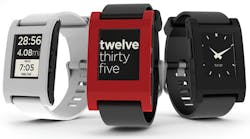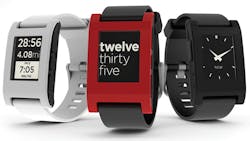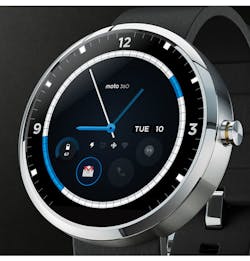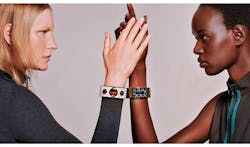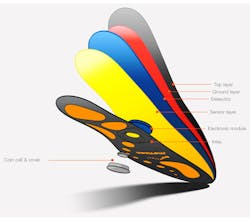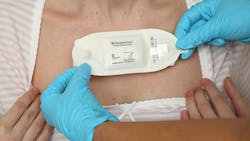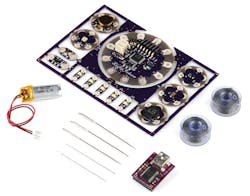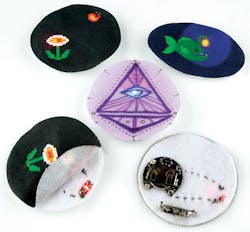What can you do with low cost, low power microcontrollers and sensors? Strap them on. Wear them in a shoe. Or build them into an e-textile. Wearable electronic technology is everywhere. Power remains a challenge, but a plethora of products exist based on currently available hardware.
Part of the wearable trend is based on technology that has come out of the smartphone trend. Compact, low-cost, low-power 3D sensors are found in most smartphones. These can include accelerometers, magnetometers, and gyroscopes. Other sensors include altimeters, pressure, and temperature. Even digital cameras and laser range finders can be found in the mix. Sensor fusion combines multiple sensor information into additional data useful to applications (see “Sensor FusionOr Sensor Confusion?”).
Download this article in .PDF format
This file type includes high resolution graphics and schematics when applicable.
Wearable technology covers a lot of ground, ranging from watches to medical devices. While the latest products employ a range of technologies, these are also in reach of the average developer.
Watches and Fitness Solutions
Smartwatches and activity trackers are now ubiquitous. Activity trackers started as basic pedometers, having since moved from clip-on fobs to wrist-based sensors. They have also increased in functionality as additional sensors have been added as well as improved sensor integration. For example, some activity trackers can monitor a user’s sleep patterns. They can track not only when a person sleeps but also movement. Add a clock to an activity tracker and you have a watch.
Of course, a smartwatch usually has all the sensors found in an activity tracker allowing the smart watch to perform all these function as well as others. The big difference is that a smartwatch usually has a larger, more functional display and the computational power of the smartwatch can be utilized by apps just like a smartphone.
One of the first smartwatches was the Pebble Watch (Fig. 1) that was born in a $10 million Kickstarter campaign in 2012. It is now $99, with the latest Pebble Steel version running $199. The latter has a thinner body with Corning Gorilla Glass and metal buttons. They have a 1.26-inch, 144- by 168-pixel, e-paper display (see “Electronic Paper Provides Design Freedom”). The e-paper display is part of the reason the Pebble can run a week between charges. The watch has a waterproof rating of 5 atmospheres.
A USB cable is used for charging but communication is done using Bluetooth 2.1 and Bluetooth 4.0 LE (Bluetooth Low Energy). Typically the watch is wirelessly linked to a smartphone. This allows a user to see incoming calls and messages without looking at the smarthphone. Some question the need for this functionality while others swear by it. A built-in motor provides haptic feedback as well.
The watch includes a magnetometer, ambient light sensors and a three-axis accelerometer. This allows it to act as an activity monitor. It works with Android and Apple smartphones.
Inside is an STMicroelectronics STM32F205RE with a high-performance ARM Cortex-M3 MCU running at 120 MHz (see “Single Cycle 120MHz Cortex-M3 Delivers 150 DMIPS”). It has 32 Mbits serial flash allowing download apps to run on the watch.
The Motorola Moto 360 (Fig. 2) is based on more recent technology. It has a Texas Instruments (TI) OMAP 3 processor with an ARM Cortex-A8 core. It has 4 Gbytes for flash and 512 Mbytes of RAM. It runs Google’s Android Wear operating system.
The Moto 360 as a 1.56-in backlit color LCD display with a resolution of 320- by 290-pixels (205 ppi). The display is more demanding in terms of power compared to an e-paper display but it provides a more colorful display. This allows features like a background that reflects weather to alerts with sophisticated animations.
The watch links to an Android smartphone via Bluetooth 4.0 LE. It needs to be charged more often than the Pebble but it uses Qi wireless charging that can be very convenient.
The Moto 360 is not the only new smartwatch on the block. There is lots of competition — most notably from the Apple Watch, scheduled to ship in 2015. Apple’s product will work with the iPhone. Smartphone users may be locked into a platform based on their smartphone’s OS.
Intel is looking to make a fashion statement with Mica (Fig. 3). At around $1000, it is pricey but stylish. It provides functionality similar to low cost activity trackers.
The wrist is not the only place wearables can be found. Sometimes they may be underfoot.
Moticon OpenGo Sensor Insole (Fig. 4) has 13 pressure sensors. It also has a 3-D accelerometer and temperature sensor. This allows the microcontroller to track a user’s movement and balance in significantly more detail than the typical activity tracker. It communicates using ANT+ wireless technology. The insoles are matched with an ANT+-enabled flash drive. The system can monitor a user for up to four weeks. In the future, Bluetooth 4.0 LE will be used allowing information to be sent directly to smartphone or smartwatches.
OpenGo is being used to track orthopedic patients after they had received lower-extremity surgery. In theory, it could be used for a host of other medical applications from assisting with rehabilitation of a range of orthopedic problems to balance and load bearing issues for geriatric patients.
Optical Wearables
Google’s Google Glass is one of the more prominent optical devices available, but this optical head-mounted display (OHMD) is by no means unique in this space. More expensive OHMDs are used in helicopters and other aircraft. Like smartwatches, Google Glass is typically paired with a smartphone via Bluetooth.
Google Glass has a small display that can be viewed with one eye. It has a resolution of 640- by 360-pixels and is equivalent to viewing a 25-in display. There is also a built-in camera. Audio support is handled by a bone conduction system. Other sensors include 3D gyroscope, 3D accelerometer, 3D magnetometer, and light and proximity sensors. The processor is TI OMAP 4430 with 16 Gbytes of flash and 1 Gbyte of RAM. It runs Android and has Bluetooth and Wi-Fi connectivity. As with many smartphones, Google Glass is designed to run a day before recharging.
Google Glass has raised well-documented privacy and security issues. Some establishments have even banned it although it is simply a more obvious incarnation of the functionality found in the typical smartphone.
Another company that has Google Glass-like technology is Vuzix. Their products range from the M100 Smart Glasses with a single eye display to augmented and virtual reality glasses that target industrial applications.
Google Glass allows a user to view the world as well as its built-in display, but some systems provide a more immersive environment, like 3D goggles. One of the more notable incarnations is Samsung’s Oculus Rift (see “Consumer Electronics Take User Interfaces Beyond Your Fingertips”).
Oculus Rift provides a virtual reality environment and blocks out light from the local environment. Each eye has its own 960- by 1080-pixel display with a 75 Hz refresh rate. Some developers have come up with ways to combine the local environment with virtual reality using cameras mounted on the system. Vuzix has a similar product that also incorporates display glasses with cameras.
Medical Wearables
Wearable medical technology is moving from big, bulky and obvious to tiny and hidden. Many devices provide medical-related information like a person’s pulse or movement information but these are not considered medical telehealth devices. They have not received approval form the Food and Drug Administration (FDA).
Still, this same technology is being incorporated into medical devices. Sensium Healthcare’s Sensium Vitals sensor (Fig. 5) is a patch that provides real time patient status including heart-rate, respiration and local temperature (watch “London Calling - Monitoring Patch Checks Vital Signs Every Two Minutes”). Other sensor are being employed to provide electroencephalogram (EEG) and electrocardiogram (ECG/EKG) data
The Continua Personal Connected Health Alliance (PCHA) is an open industry organization that supports collaboration within the healthcare industry. Its standards are based on industry standards like USB, Bluetooth and ZigBee. These standards address interoperability. For example, there is a USB personal healthcare device class (PHDC). FDA approval is a separate but necessary issue.
The challenge for medical wearables is more than just getting a product to work. FDA approval is required for most products in this space and there are legal issues such as the Health Insurance Portability and Accountability Act (HIPAA). Security is paramount, and long-term support and reliability is critical. Solutions will be more expensive than consumer style products but they are likely to be significantly less expensive than older medical solutions.
DIY Wearables
Wearable technology is compact and the final form is likely to require a good deal of custom production support but turning an idea into a prototype is within the grasp of most DIY (do it yourself) and commercial developers. Development platforms like Freescale’s Wearable Reference Design (WaRP) application processing module has an i.MX6Solo with a 1 GHz Cortex-A9 core (see “It Takes A WaRPed Mind To Design Wearable Tech”). The module has Wi-Fi and Bluetooth support.
Intel’s Edison module has a dual core, x86 Atom processor plus Intel’s Quark microcontroller (see “How Many Quarks Does It Take To Make An IoT?” on electronicdesign.com). The module also has Wi-fi and Bluetooth built-in. Like WaRP, the platform is designed for mobile, battery-based solutions.
Sparkfun’s LilyPad (Fig. 6) is more than just a module. It consists of a collection of microcontroller modules, sensors, buttons and display modules. LilyPad was developed in conjunction with Leah Buechley, associate professor at MIT’s Media Lab where she directs the High-Low Tech research group.
The microntroller modules are built around Atmel microcontrollers. This is the same platform found on Arduino modules and LilyPad modules share the architecture and development tools. The LilyPad Arduino 328 Main Board has an ATMega328 on-board. A USB-based FTDI board provides debug support. The ProtoSnap – LilyPad Development Board includes a collection of modules along with conductive thread. Just make sure the batteries are removed before washing. These are prototypes after all.
E-textiles — also known as electronic textiles, smart textiles, or smart fabrics — are fabrics that enable digital components (including small computers), and electronics to be embedded in them. Many intelligent clothing, smart clothing, wearable technology, and wearable computing projects involve the use of e-textiles.
This file type includes high resolution graphics and schematics when applicable.
The products and technologies presented here are just the tip of the iceberg. Some markets like smart watches have lots of competition with similar products. Medical is where wearable technology will ultimately break new ground, but FDA approval takes a long time. Augmented and virtual reality glasses allow technicians to tap information about devices they are working on.
